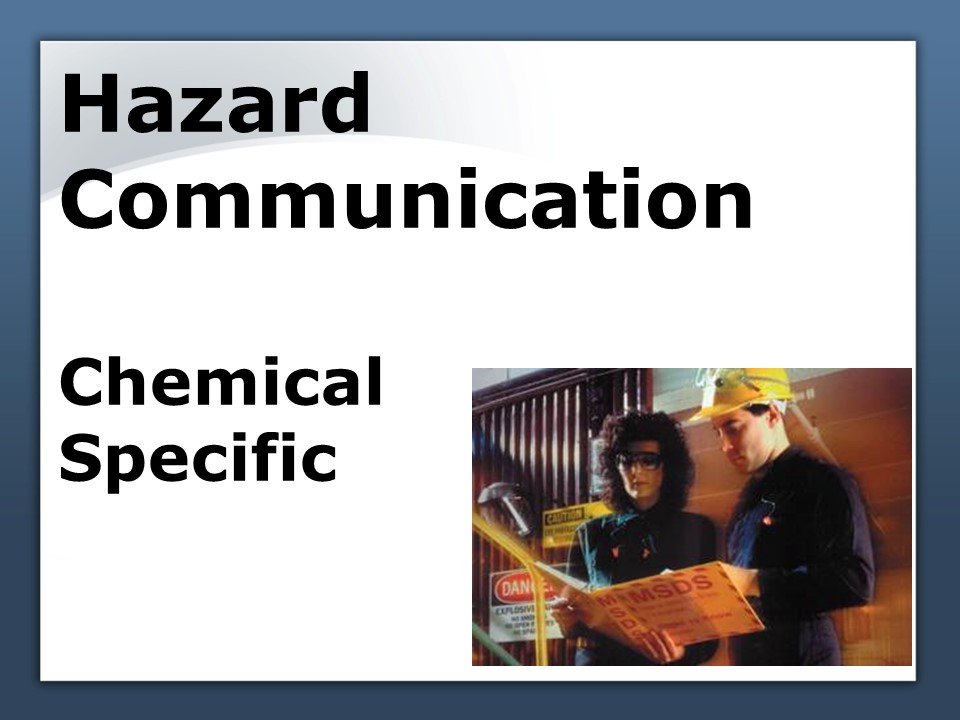Hazard Communication Chemical Specific - PowerPoint PPT Presentation
Title:
Hazard Communication Chemical Specific
Description:
Determine hazardous chemicals in work areas Consult the list of hazardous chemicals Chemical manufacturers ... for safe handling/use ... HAZCOM - Chemical ... – PowerPoint PPT presentation
Number of Views:513
Avg rating:3.0/5.0
Title: Hazard Communication Chemical Specific
1
Hazard CommunicationChemical Specific
2
Determine hazardous chemicals in work areas
- Consult the list of hazardous chemicals
- Chemical manufacturers supply hazard
information
1a
3
Determine hazardous chemicals in work areas
- Chemicals at this facility
- Chemicals in your work area
1b
4
Health hazards
Health hazards cause health effects upon exposure
- Acutely toxic
- Chronically toxic
- Carcinogenic
- Mutagenic
- Teratogenic
- Sensitizing agent
- Corrosive
- Irritant
2a
5
Physical hazards include any chemical that is
- Combustible liquid
- Compressed gas
- Explosive
- Flammable
- Organic peroxide
- Oxidizer
- Pyrophoric
- Unstable (reactive)
- Water-reactive
2b
6
Protective measures
- Work practices
- Engineering controls
- Personal protective equipment
3a
7
Dispensing and storage techniques
- Know how to properly handle hazardous chemicals
- Check for MSDS information
4a
8
Dispensing and storage techniques
- Take the following precautions
- wear recommended safety equipment
- work in well-ventilated areas
- store and dispense of chemicals properly
- avoid creating sparks near hazardous chemicals
4b
9
Detecting hazardous chemicals in work areas
- Know how to detect whether a chemical has been
spilled, or is otherwise present in the
environment in an uncontrolled manner
5a
10
First aid procedures
- Read MSDSs for first aid information
- Have emergency eyewash stations and showers
available
6a
11
Emergency eyewash stations
- Know where to go for treatment
- Drench eyes/skin with water
7a
12
Emergency eyewash stations
- If a chemical splashes into eyes
- get to a flushing station immediately
- hold eyes open with your fingers - lift your
eyelids - look directly into stream of water
- flush eyes for 15 minutes
- get medical attention
7b
13
Emergency procedures
- Different chemicals have different emergency
procedures - Refer to MSDSs
8a
14
Emergency procedures
- Refer to 29 CFR 1910.1200
- Refer to 29 CFR 1910.120
8b
15
Material safety data sheets
- Primary tool for getting detailed chemical
information - Must be readily available
9a
16
Material safety data sheets include
- Chemical identity
- Physical and chemical characteristics
- Physical and health hazards
- Primary routes of entry
9b
17
Material safety data sheets include
- PEL, TLV, other exposure limits
- Whether it is a carcinogen
- Precautions for safe handling/use
- Recommended engineering controls
9c
18
Material safety data sheets include
- Emergency first aid procedures
- Date of preparation
- Name, address, phone number of manufacturer,
importer, responsible party
9d
19
Material safety data sheets
- MSDSs may contain recommendations from ANSI
- MSDSs also provide information regarding
- signs and symptoms of exposure
- personal protective equipment
- spill and leak clean-up
- labeling information
9e
20
Report the need for MSDSs
- Check with supervisor if MSDS appears to be
missing - Chemical suppliers provide MSDSs
10a
21
Report the need for MSDSs
- MSDSs must be part of the facilitys HazCom
program - Your employer makes sure they are kept up to
date
10b
22
Labeling requirements
- Labels warn of potential dangers
- Labels are not intended to be the sole source
of information - Labels serve as an immediate warning
11a
23
Labeling requirements
- Labels must be keyed to MSDSs
- Labels must contain
- the identity of the hazardous chemical
- appropriate hazard warnings
- the name, address of the chemical manufacturer,
importer, other responsible party
11b
24
Labeling requirements
- Ensure that labels do not come off, become
smudged or unreadable - For hard-to-label containers, use
- signs or placards
- process sheets, or batch tickets
11c
25
Labeling requirements
- Be able to quickly identify the general hazard of
any material - NFPA system identifies
- health hazards
- flammability hazards
- reactivity hazards
- special hazards
11d
26
Labeling requirements
- Be able to quickly identify the general hazard of
any material - HMIS system identifies
- health hazards
- flammability hazards
- physical hazards
11e
27
Hazards of nonroutine tasks
- Know what chemicals you work with and their
hazards - Know the contents of pipes
12a

